This post may contain affiliate links. If you click through a link and make a purchase, I may receive a commission at no additional cost to you. As an Amazon Associate, I earn from qualifying purchases. Read the full disclosure here.
Lengthy hours on a computer plus bad posture at your desk equals a recipe for aches and pains.
Here are the 7 best foam rolling exercises for posture, plus how to do them!
Disclaimer: This content is for educational purposes and is not medical advice. Read the full disclaimer.
Foam rolling for posture step-by-step
1. Hip flexors
When we sit, the hip flexors are in a shortened position. Couple that with a slumped posture rocking the pelvis backward into a posterior tilt for hours on end, and you’ve got some tight hips.
Note that the iliopsoas is one of the primary hip flexors; however, due to its deep location in the abdomen, you’re not really going to be foam rolling this muscle.
Other muscles that assist with hip flexion, rectus femoris (one of the four quad muscles), sartorius, along with fascia, are more superficial and can benefit from this exercise.
For more ways to stretch the hip flexors, visit the hip flexibility library.
How to perform
- Locate the “hip bones” on the front of the pelvis.
- The area you’re looking to release is between the front of the pelvis and the very top of the thighs (quadriceps).
- Lie face down and place the foam roller where the hips meet the pelvis.
- Support yourself on your elbows as if you were in a plank position.
- Do not roll higher than the “hip bones” on the pelvis, even just staying still and allowing the hips to melt into the foam roller will feel relieving.
- Perform for 30 seconds to 2 minutes.
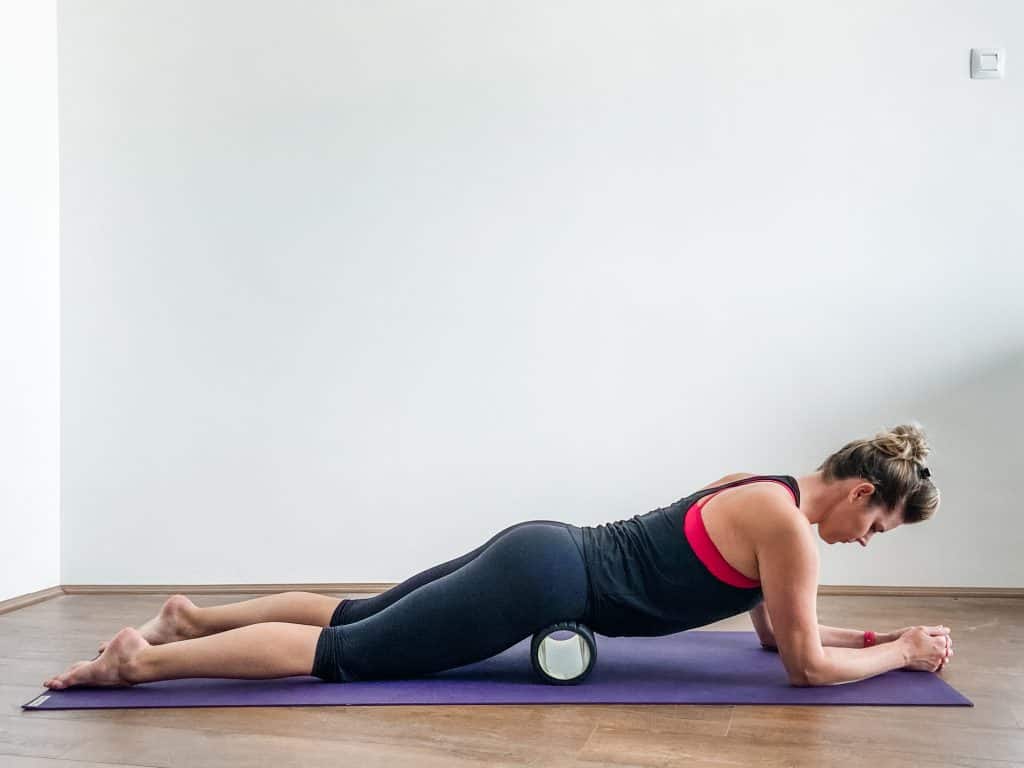
2. Hamstrings
In a seated position the hamstrings are shortened. Rounding the lower back and “slumping” down tilts the pelvis backward (posteriorly), which shortens the hamstrings even further.
Over time, this position can cause you to feel like you always have tight hamstrings. (Read Yoga for Hamstrings – Easy Ways to Protect & Prevent Injury if this is you!)
View more hamstring flexibility exercises here.
How to perform
- Place the foam roller under the hamstrings (back of the thighs).
- Place your hands next to your hips and gently support your weight through your hands.
- Lift your bottom and slowly roll over the length of the hamstrings (from just above the knees to the sit bones)
- Perform for 30 seconds to 2 min
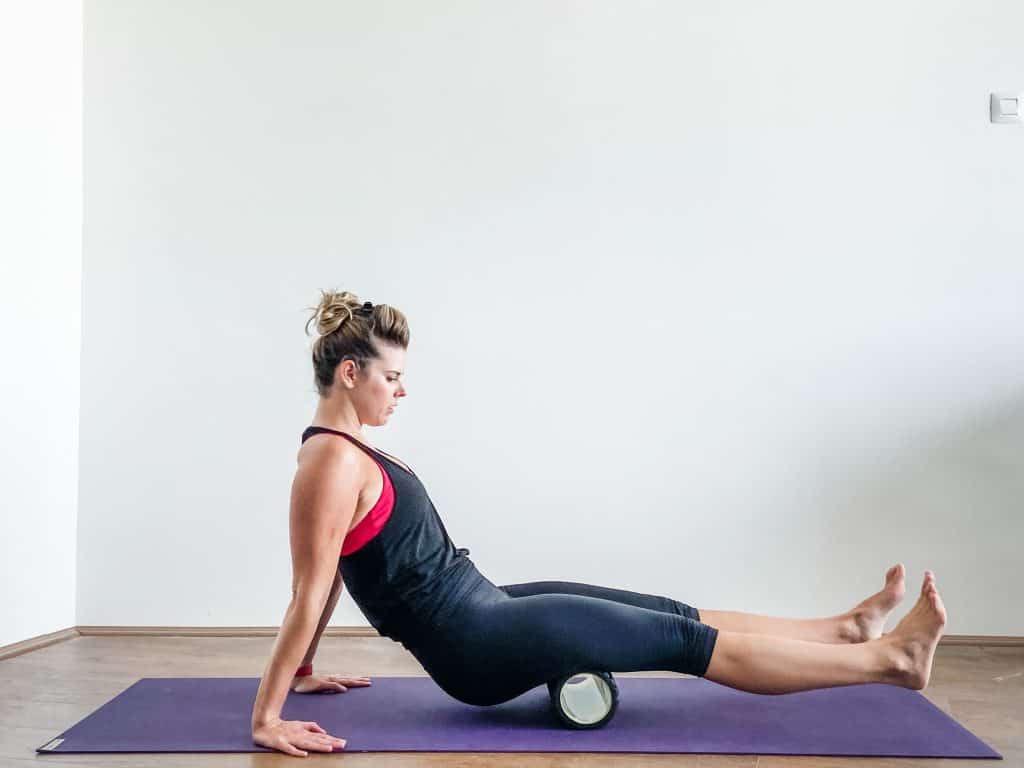
3. Glutes
This area can get cranky because we sit on it All. Day. Long.
Glute strength is important to protect the lower back. Sadly, they don’t get used much sitting at a desk.
How to perform
- Sit on the foam roller and support yourself with your hands on the floor behind you. Your feet will also be flat on the floor as if you were in a “crab walk” position.
- One side at a time, shift over onto one glut and slowly roll back and forth, pausing if you find a tight spot.
- Crossing that ankle to the opposite knee in a figure 4 position will intensify the stretch.
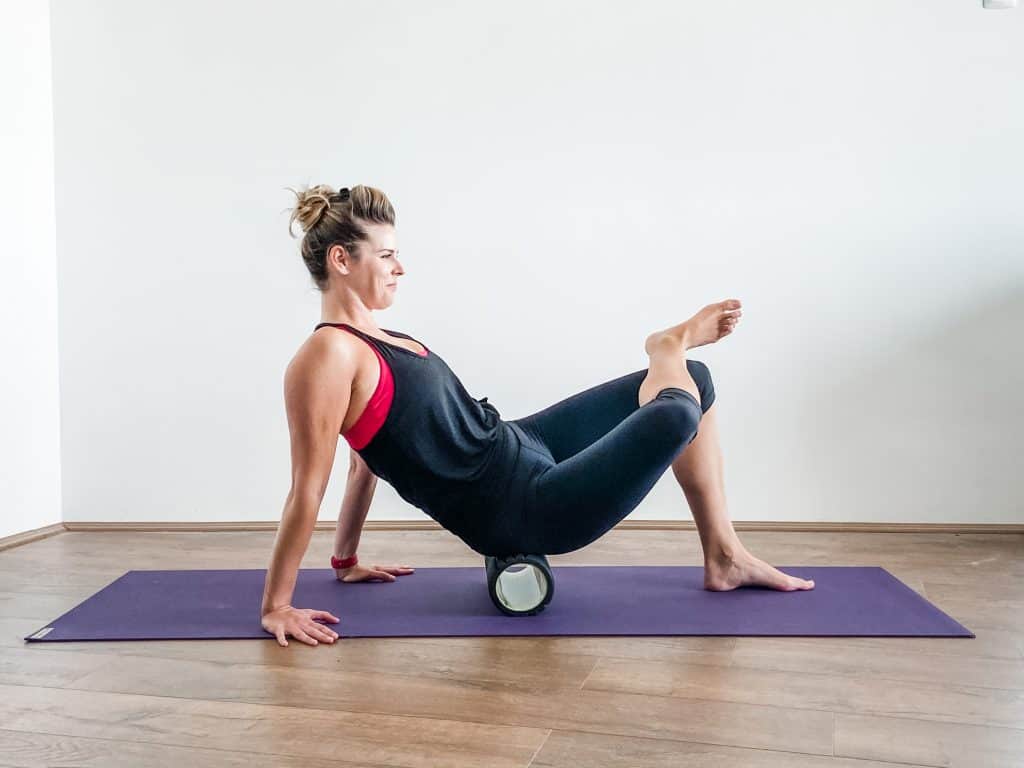
4. Thoracic spine extension
Most of the day is spent in flexion, with the upper body slumped over a computer.
Give the spine some mobility in the opposite direction with gentle thoracic spine (upper back) extension.
This method is a joint mobilization, providing gentle pressure as you move the spine through flexion and extension and can also help with chronic neck pain.
Anyone with significant scoliosis, thoracic kyphosis, or osteoporosis should consult with a physical therapist for alternative options as mobilizing with a foam roller may be too aggressive.
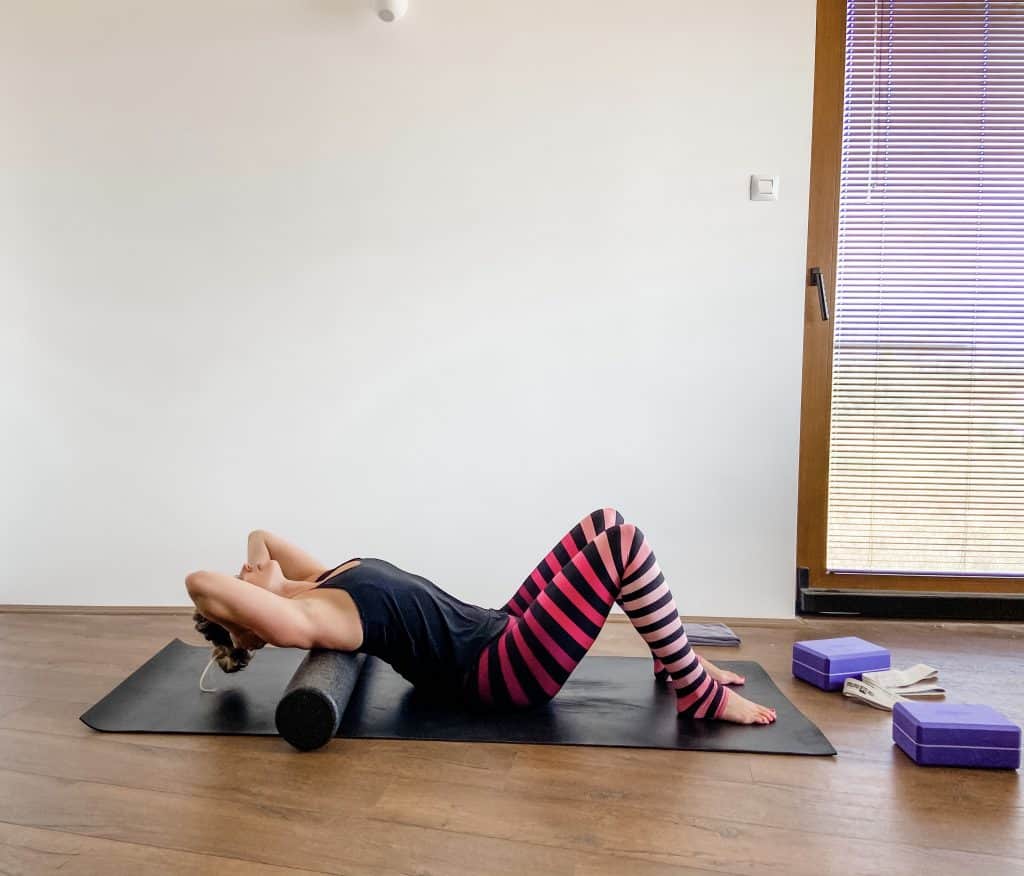
(Those super awesome striped leggings are K-Deer, for my fashionistas who just need to know!)
How to perform
- Sit on the floor and place the foam roller perpendicular to your spine at the level of the shoulder blades.
- Cradle your head and neck with your hands. You’ll want to keep your neck in neutral while performing this stretch.
- Gently roll back, extending over the foam roller only as far as you feel comfortable.
- Slowly lift back up and repeat ten times.
- Keep your bottom on the floor the whole time, and keep your gaze on the top of your knees to protect your neck alignment.
Visit the spine flexibility library for more ideas to improve spine mobility.
5. Pec stretch
Working at a desk leads to a flexed and rounded posture throughout the upper back and the shoulders.
This forward rounding places the pectoral muscles (chest muscles) in a shortened position. Counteract this by opening up the chest.
You will need a full length (36-inch) foam roller for this exercise.
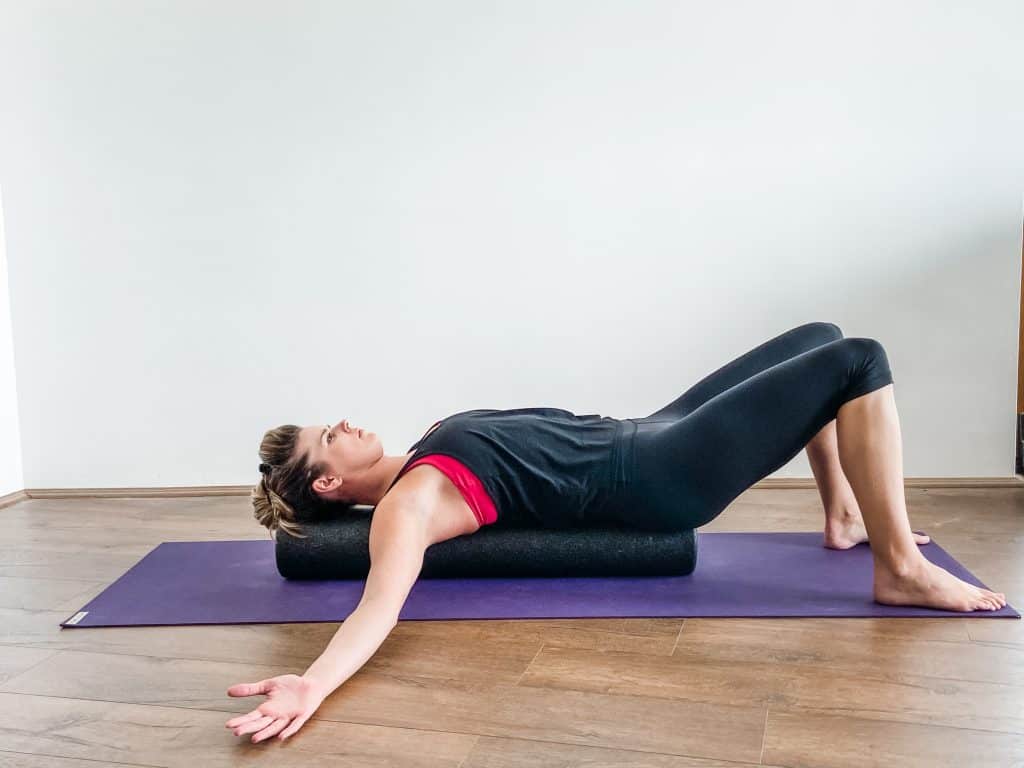
How to perform
- Lie on the foam roller so that it’s along your spine, with both your head and sacrum supported.
- Slowly extend your arms out to a T position and stay for 30 seconds.
- Variations include putting the arm at a goal post position or a Y. Some positions may be more intense than others.
- This option may be too intense for some because the foam roller lifts you and gives extra space. If there is pain or tingling, you can always try without the roller and work up to it as your flexibility and mobility improve.
This video demonstrates stretching the pec muscles with a foam roller.
6. Shoulder mobility
This exercise can also open up the pec muscles and mobilize the shoulder joint at the same time. The height of the foam roller allows for some additional movement.
How to perform
- Lie on the foam roller so that it’s along your spine, with both your head and sacrum supported.
- Clasp hands behind your head/neck but do not lift your head
- Slowly bring your elbows in toward your nose, they may touch, they may not.
- Gently let your elbows fall toward the ground.
- Repeat 10-20 times.
Bonus for shoulder mobility – foam rolling for lats
If you haven’t read Keys to Maintain Healthy Shoulders, you’re in for a treat. Tightness in the lats can affect shoulder mobility.
- Lie on your side with your arm extended overhead and the palm facing up.
- Place the foam roller under your arm, toward the back of your arm pit.
- Gently roll along the outside border of the shoulder blade – don’t roll further onto the ribs.
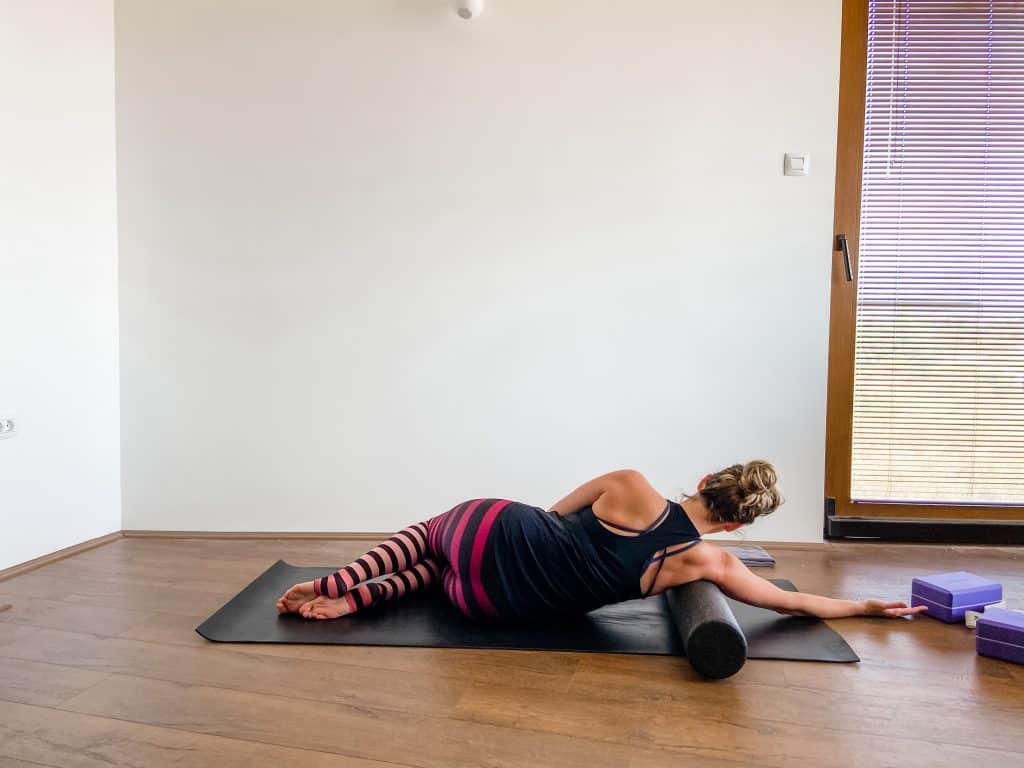
7. Suboccipital release
You might have noticed a lot of tightness in the neck muscles at the base of the skull (suboccipital muscles).
When you jut your head forward and then tilt your head up to read a screen, it can overwork these small muscles, leading to headaches.
This group is challenging to stretch because of anatomy, but if you’ve ever had a physical therapist or massage therapist cup the base of your skull with their fingers, you know how relieving this feels.
Luckily, in a pinch, two tennis balls can get into this area. You can also use these special massage lacrosse balls or try this occipivot pad.
How to perform
- Tape two tennis balls together, they will resemble a peanut-like shape (they can also be tied in a sock)
- Lie on your back and place the tennis balls at the base of the skull
- Allow gravity to use the weight of your head to release these muscles gently – don’t forcefully press your head into the tennis balls
- Gentle yes/no nods can add some mobility.
This video demonstrates a self suboccipital release with two lacrosse balls.
What NOT to do with a foam roller
- Don’t aggressively and rapidly roll over tissue without control.
- Don’t roll over bony prominences such as the side of the hip.
- Put direct pressure over arteries, veins, nerves, or the abdomen.
- Don’t roll over recent injury/surgery, open wounds, tumors, blood clots, fractures, neuropathies, or other systemic medical conditions.
- Ask a medical provider for guidance with pregnancy, osteoporosis, or any other medical condition.
Common computer-related injuries
Poor posture for prolonged periods causes excess strain on tissues.
Usual suspects that contribute to poor posture at a desk usually looks like a slumped letter “C”, rounded shoulders and upper back, sticking the head forward to read a screen, and rounding at the lumbar spine and pelvis (posterior pelvic tilt).
Injuries from poor posture are usually more repetitive strain that has developed over time, not something that will send you to the ER today.
Complaints are often muscle tightness, muscle soreness, or tendonitis.
Some of the most common computer-related complaints include:
- Neck pain
- Headaches/migraines/eyestrain: including headaches as a result of poor cervical spine posture
- Shoulder pain
- Tennis elbow
- Carpal tunnel syndrome
- Upper/lower back pain
- Hip pain
Can foam rolling improve posture?
The human body needs to move. Even if your workstation ergonomics are top-notch, we can’t stay static all day long.
Proper posture is dynamic, not some perfect static position we’re trying to achieve. Bad posture is only bad when we spend too long in one position.
Improving your posture is multi-faceted and includes strengthening, stretching, and recognizing poor posture habits.
So how does foam rolling exercise help better posture?
Foam rolling is a tool to give yourself a cheap massage and help with mobility work. Postural imbalances can lead to pain and overuse injuries over time.
Your body weight is used to apply pressure and slowly roll over sore muscles to mobilize soft tissue, relieve muscle tension, and improve ROM (range of motion). You will also hear the terms trigger point release and self-myofascial release used.
Though self-massage for tight muscles is the most common use, there are other uses for foam rollers, including joint mobility exercises and props for stability exercises such as in Pilates.
Foam rollers are inexpensive and lightweight, so you can keep one at the office or at home to help you roll out after a long day at the computer.
Ten minutes can make a significant difference in how you feel, help improve posture and reduce the risk of injuries.
Which foam roller is right for me?
There are so many kinds to choose from, and it can be a little overwhelming.
Check out How To Choose A Foam Roller Made Easy to clear up all those questions.
The average roller is 6-inches in diameter. Full-length foam rollers can be up to 36-inches long.
Shorter rollers are approximately 12-18 inches long and can be a compact option for limited space or traveling. The Trigger Point Grid Roller is another one of my favorites. It also has a hollow inside you can fill with socks if you’re taking it in your suitcase!
Most foam rollers come in low, medium, or firm density. You can take care of your basic foam rolling needs with the average medium or firm-density roller. The right density for you will depend on how much pressure you want.
Other stretching and mobility tools
If you’re looking for something a bit more exciting than a regular foam roller, check out the vibration therapy muscle recovery tools at Sidekick.
What makes vibration therapy better?
There is some evidence that vibration can decrease pain via the gate control theory, which modulates pain sensations sent back down from the central nervous system based on sensations put in.
The gate control theory’s most straightforward example is when you rub an injured spot, for example, right after smashing your elbow into a door frame. Ouch.
For a foam roller that also does vibration therapy, look into the Trigger Point Grid Vibe Plus.
This article also dives deep into vibration foam rollers vs. massage guns for all the details on relieving muscle tension.
For specific, trigger point therapy, myofascial release balls are another option. They also take up less space and are more travel friendly – and will feel great after a long car or plane trip!
Save Over 50% On The Ultimate Back Pain Bundle by Chirp + Free Shipping Over $99
Read The Best Affordable Physical Therapy Equipment for Home to learn about the most sought after physical therapy tools to make your home exercises easier!
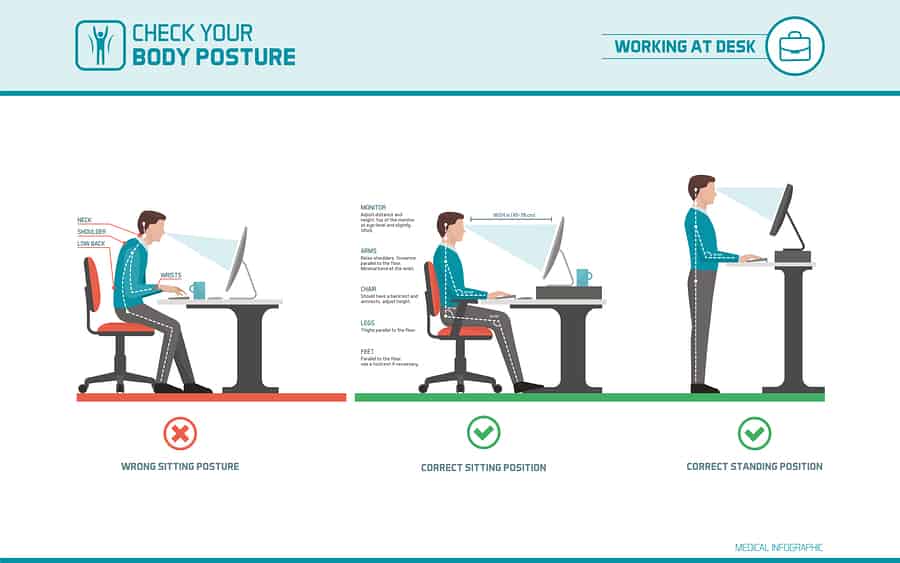
Tips for good desk posture
- Avoid working on the couch or bed for prolonged periods.
- Use an ergonomic chair that can be adjusted to your height.
- Use a footrest if you have trouble reaching the floor or a rocking footrest to keep your calves moving.
- Use a lumbar support pillow.
- Place your monitor is straight ahead or use hardware to be able to swivel for your needs.
- Make the keyboard and mouse easily reachable to avoid awkward positions, 1-2 inches above the thighs.
- Consider using a standing desk to switch back and forth between sitting and standing.
- Take short breaks every 50-60 minutes for both your mind and body.
- Screen breaks are good for your eyes to reduce eyestrain by focusing on other things in your environment. (This doesn’t mean take a 10 min break and scroll through your phone.)
- Use a headset or headphones if you’re on the phone a lot.
- Do exercises and stretches to improve mobility.
Check out Do You Need A Standing Desk? for the pros and cons, plus more ideas to weave activity into your workday!
Do posture braces work?
This is another common question that skirts doing real work to fix a problem.
We’ve all seen those crazy contraptions that claim to strap your shoulders back and fix your posture!
Sorry, to make improvements in strength, flexibility, and habits, your body kindly requests the presence of your company.
There are a few issues with posture braces.
When used too much, posture braces may serve as a crutch, weakening posture muscles over time because there’s no incentive for your muscles to work. You may even start to feel worse when you don’t wear it.
Posture braces can make existing problems worse. Posture is also more of a whole-body involvement. If you correct just one area, it may make other areas worse due to dramatic changes in alignment. You’re missing critical pieces of postural awareness.
They also may not be adjusted correctly, or you’re possibly over correcting.
Braces are not a cure for poor posture. A common thought is that wearing a brace “educates” your body on how to stay.
To truly improve posture and movement, you need to focus on stretching, strengthening, activity modification, and body awareness. This is the best way to educate your body.
You’re better off trying something like the Upright Go 2, to help improve your posture. It’s not a brace, but rather a small sensor you wear to provide a vibration cue when it senses you’re in poor posture.
Wrapping up
Moving well and moving often help play a significant role in injury prevention.
Foam rollers are an inexpensive tool to help you maintain good posture and mobility. You can use these tools to mimic a deep tissue massage and grab some pain relief at home.
Keep in mind that no matter how optimal your desk set up, humans need to move and take breaks. Even “good posture” can cause aches and pains if you stay in one position for too long.
Ten minutes out of your day to do some foam rolling self-care can make a tremendous difference.
Still don’t have a foam roller? Join the club!
You might also like:
- Shake Off Text Neck with These Pro Tips
- The Best Affordable Physical Therapy Tools for Home
- Do You Need A Standing Desk?
- Lower Back Pain: Strategies to Stay Active
featured image credit: fizkes / bigstockphoto.com
References
Kim D, Cho M, Park Y, Yang Y. Effect of an exercise program for posture correction on musculoskeletal pain. J Phys Ther Sci. 2015;27(6):1791‐1794. doi:10.1589/jpts.27.1791
Madhwani KP, Nag PK. Effective Office Ergonomics Awareness: Experiences from Global Corporates. Indian J Occup Environ Med. 2017;21(2):77‐83. doi:10.4103/ijoem.IJOEM_151_17
Sigurdsson SO, Artnak M, Needham M, Wirth O, Silverman K. Motivating ergonomic computer workstation setup: sometimes training is not enough. Int J Occup Saf Ergon. 2012;18(1):27‐33. doi:10.1080/10803548.2012.11076912


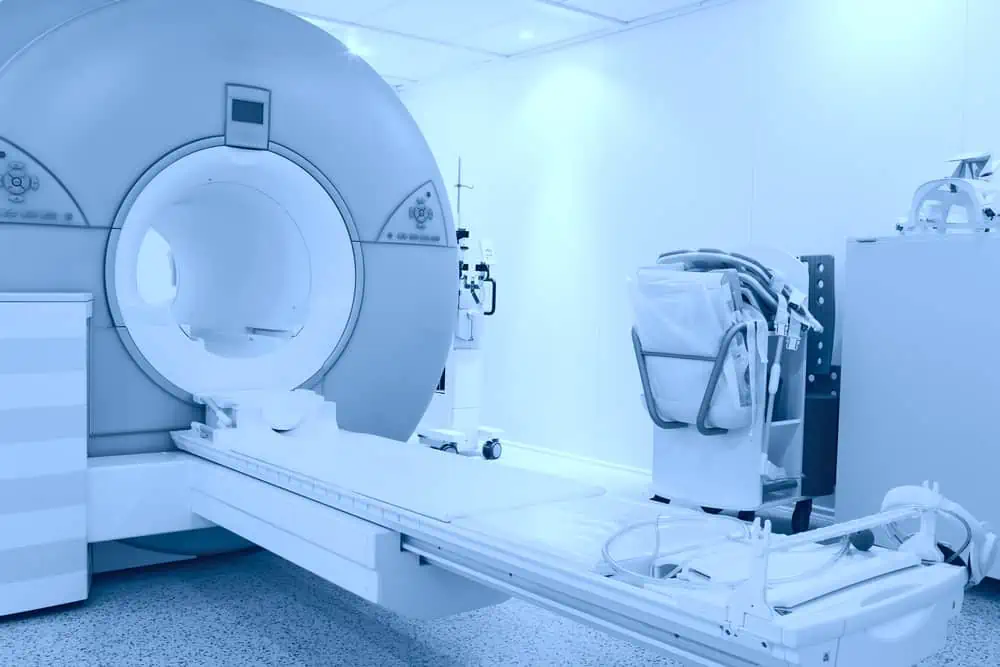

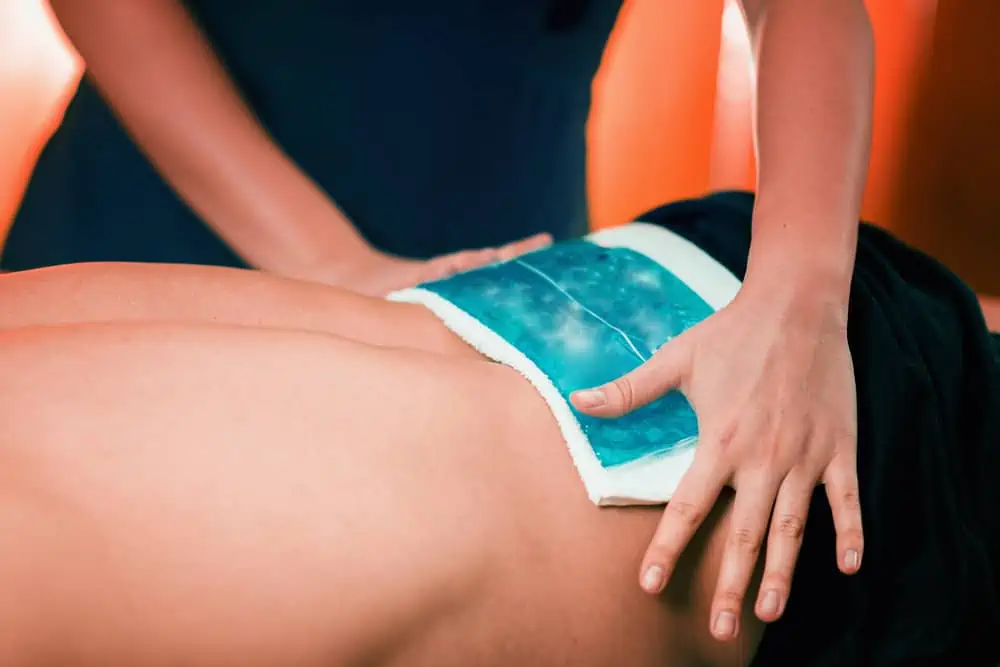
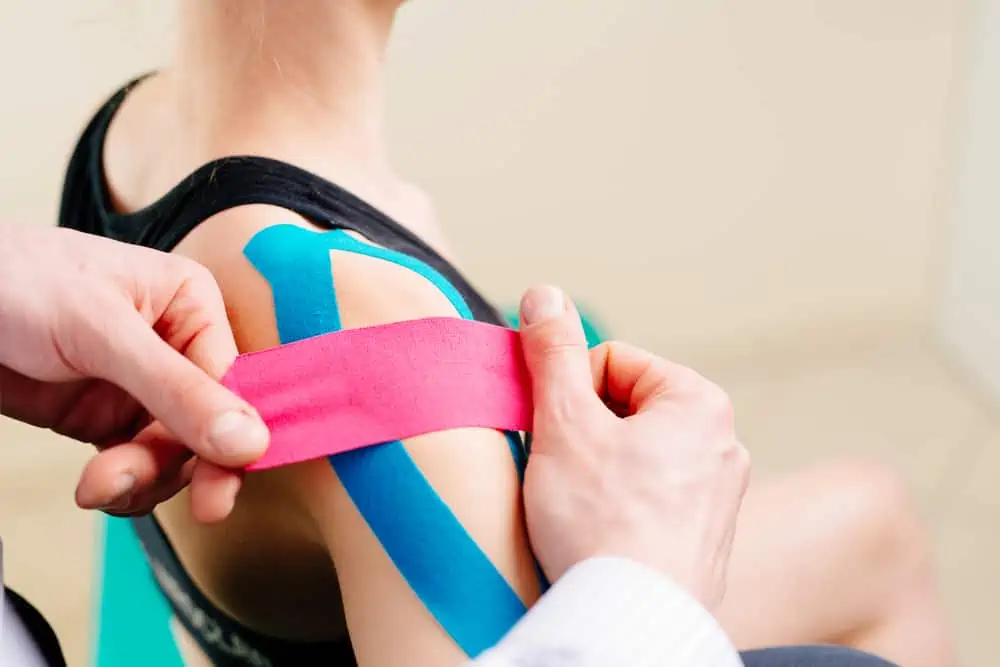
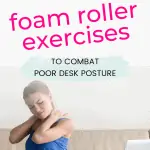
I love this. I have never heard of a foam roller. I have awful back issues, so I will be looking for one… soon. I NEED a new office chair, and a desk top computer. My laptop compromises all of my angles.
Yes, proper set up is so important. And foam rolling is great to supplement! Thanks for reading.
Working behind a computer all day, my foam roller is essential! Thanks for some new exercises and ideas to use it.
Glad you like it, thanks for reading!
Thanks for sharing this. I honestly don’t know how I survived before I started foam rolling. I’ve done it close to daily, for the past few years.
I have a love/hate relationship with my foam roller. lol
There are a lot of tips I could for sure, and I will bookmark to come back to! Thank you so much for this in-depth post.
You hit my life on the computer right on the target! I know all the proper ways to sit, get up and stretch .. basically the how-to take care of your body, but doing these things is a completely different story. I am going to dig out my foam roller and keep this article as a reference. Thanks for the awesome detailed guide!
Thanks for these exercises. I’ll have to try the with our foam roller.
It’s almost like you read my mind with this post! I just pulled my foam roller out of the closet this morning because working from home has my body in so much pain lately. I can’t wait to try some of these tonight!
I found this post in the right time. I’ve been working on the computer a lot lately and I definitely have problems with my neck and back. Got a roller too bit I didn’t know how to use it properly. Thanks for your tips now I go and try them all.
I love this post! Thank you so much for the information! I sit at a desk all day and THEN go workout pretty heavy. I have a foam roller but didn’t quite know how to use it. Can’t wait to try some of these!
These are great foam roller tips! I love my roller!!
I have an office job, and by the end of the day, my upper back and neck are usually the ones barking at me! Thanks for all the helpful tips!!
I think I need a foam roller to have at my desk! Thanks for the great tips!
This is great. I’m struggling with this right now. On Sunday I must have been working too long at my computer. I’ve been in pain ever since. It started as a stiff neck. I’m really in pain. I’m going to get one of these to help myself.